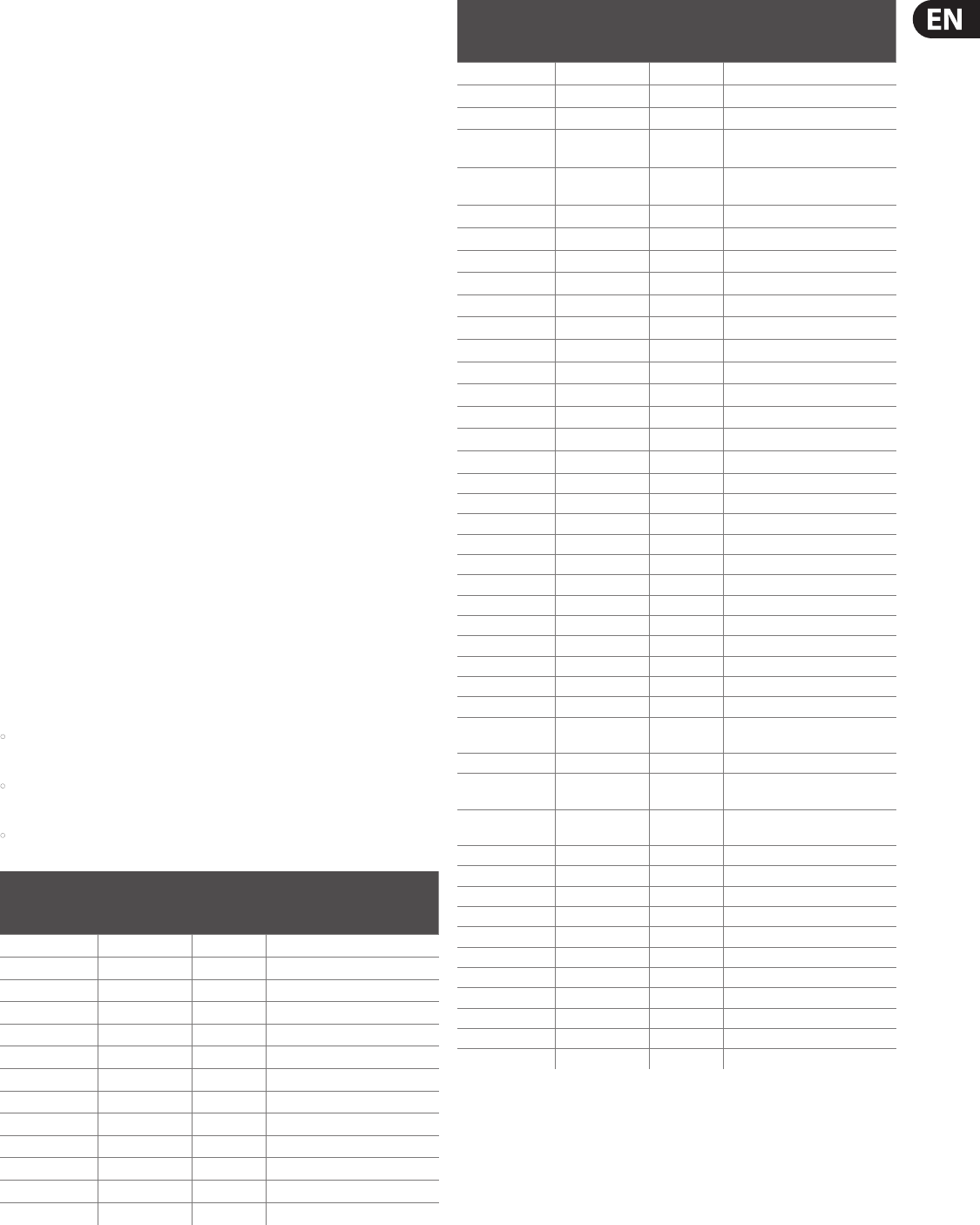
15 V-AMP3 User Manual
behringer.com
MIDI
MIDI connections
The MIDI standard (Musical Instrument Digital Interface) was developed in the
early ‘80s to enable dierent makes of electronic instruments to communicate
with each other. Over the years, the range of MIDI applications has constantly
expanded, and today it is standard practice to network entire recording studios
using the MIDI standard. The heart of such a network is a computer with
sequencer software that controls not only all the keyboards but also aects other
peripheral devices. In such a studio setup you can control the V-AMP 3 in real
time from a computer. For live performances in particular, you can also use a MIDI
foot controller to control both eect parameters and preset changes.
The MIDI connectors are international-standard 5-pin DIN connectors. To connect
your device to other MIDI equipment you will need dedicated MIDI cables.
They are commercially available in various standard lengths.
MIDI IN: This receives MIDI controller data. The receiving channel can be
adjusted in EDIT mode by pressing the A button and then using the arrow keys.
MIDI OUT/THRU: This sends data to a computer or any other device. You can
transmit both preset data and parameter changes. If set to MIDI THRU,
the V-AMP 3 does not send its own MIDI information, but passes on the signal
received at the MIDI IN connector. The TAP LED lights when the V-AMP 3 is set to
MIDI THRU (see the Edit mode section for details).
Sending/receiving MIDI SysEx data
The V-AMP 3 can receive system-exclusive data from other MIDI devices
provided that the MIDI function (button A) has been activated in EDIT mode.
However, this means that all presets on your device will be overwritten
automatically. You can also transmit MIDI data from your V-AMP 3 to other
devices (total dump) by switching to EDIT mode and holding the MIDI button (A)
until the display reads “d.” The total dump function can be useful for transferring
all the stored data from your device to a MIDI sequencer and storing it there.
To exchange individual presets with other devices, such as another V-AMP 3
or a PC:
Switch the transmitting V-AMP 3 to EDIT mode by pressing the BANK UP and •
DOWN buttons simultaneously.
Activate the MIDI function and briey tap the MIDI button. The preset data is •
transmitted and rst led in the temporary buer of the receiving V-AMP 3.
Store the new information in the preset position of your choice using the •
store function.
MIDI IMPLEMENTATION CHART
Function Transmitted Received Remarks
MIDI Channel 1-16 1-16 —
Mode N N —
Note Number N N —
Velocity N N —
After Touch N N —
Pitch Blender N N —
Control Change — — —
1 N (request only) Y Wah Pedal
7 N (request only) Y Volume Pedal
12 Y Y Amp Gain (0-127)
13 Y Y Amp Treble (0-127)
14 Y Y Amp Mid (0-127)
15 Y Y Amp Bass (0-127)
MIDI IMPLEMENTATION CHART
Function Transmitted Received Remarks
16 Y Y Amp Vol (0-127)
17 Y Y Presence (0-127)
18 Y Y Reverb Mix (0-127) *2
19
Y (skipped on
request)
Y
Amp Type (0-32) with default
cabinet *3
20
Y (skipped on
request)
Y Fx Type (0-15) with defaults *1
21 Y Y Fx o/on (0/127)
22 Y Y Reverb Send o/on (0/127)
23
Y Y Cabinet Type (0-15) *5
24 Y Y Reverb Type (0-8) *4
25 Y Y Noise Gate Level (0-15)
26 Y Y Drive o/on (0/127)
27 Y Y Wah o/position (0/1-127)
44 N (request only) Y pre Eect Type (0-2) *6
45 Y Y pre Eect Par 1 *6
46 Y Y pre Eect Par 2 *6
47
N (request only) Y pre Eect Par 3 *6
48 N (request only) Y pre Eect Par 4 *6
49 N (request only) Y Delay Type (0-2) *7
50 Y Y Delay Time hi (0-117) *8
51 Y Y Delay Time lo (0-127) *8
52 N (request only) Y Delay Spread (0-127)
53 Y Y Delay Feedback (0-127)
54 Y Y Delay Mix (0-127) *9
55 N (request only) Y post Fx Mode (0-6) *10
56 Y Y post Fx Par 1 *10
57 Y Y post Fx Par 2 *10
58 Y Y post Fx Par 3 *10
59 Y Y post Fx Mix (0-127) *11
60 N (request only) Y Assign Eects Control (0-15) *1
61 N (request only) Y
Amp Type (0-32) w/o cabinet
change *3
64 N Y Tap (Value > 63)
80 N Y
Request Controls
(Value = 80)
81 N (request only) Y
'Set Pos (0-15),
Set Character (32-127)
82 Y Y 'Tuner Bypass Volume (0-127)
83 Y Y 'Tuner Center Frequency (25-55)
84 Y Y Conguration (0-4=S1,S2,L1,L2,L3)
85 Y Y Live EQ Treble (0-127)
86 Y Y Live EQ Mid (0-127)
87 Y Y Live EQ Bass (0-127)
Program Change Y (0-124) Y (0-124, 127) 127=Tuner
System Exclusive Y Y see SysEx Documentation
System Common N N —
System Real Time N N —
Running Status Y (2s Timeout) Y —
MIDI Implementation Chart


















